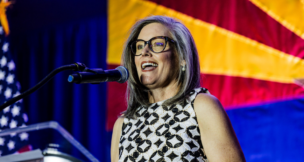Hobbs calls ESA program ‘billion-dollar boondoggle,’ urges income caps
Kiera Riley Arizona Capitol Times//January 16, 2025//
Hobbs calls ESA program ‘billion-dollar boondoggle,’ urges income caps
Kiera Riley Arizona Capitol Times//January 16, 2025//
Income caps, Gov. Katie Hobbs’ sole solid policy proposal to rein in the Empowerment Scholarship Account program in her State of the State Address, expectedly saw early support from public education advocates and immediate dismissal from school choice supporters.
Those in support of Hobbs’ plan deemed it a solid first step, given a string of zip code analyses that found high income households typically utilize the ESA program at a higher rate than low-income families.
But school choice supporters deemed Hobbs’ proposal mere rhetoric and raised the comparison to district or charter schools, which see no means-test or income cap as a determinant of entry or funding.
Ahead of the unveiling of the executive budget Jan. 17, the proposal generally left questions on structure, data collection and how any attempted bill might fare in the Legislature.
In her State of the State on Jan. 13, Hobbs ended her remarks with another call to install greater accountability in the ESA program.
“The current program is unchecked, flawed, and rife with exploitation. Three years ago, it went far beyond its original purpose, which was to support kids with special needs and military families,” Hobbs said. “Today, it has ballooned into a billion-dollar boondoggle increasingly scamming Arizonans. Other entitlements funded by taxpayers have strict oversight and income requirements. Yet the ESA program has the privilege of virtually no safeguards.”
Hobbs specifically proposed instituting “responsible” income caps and made general calls to “ensure taxpayers know where their money is going and create real responsibility for taxpayer dollars.”
“Members of this Legislature must ask themselves: Do we finally put guardrails around ESAs to protect against fraud, waste and abuse – or do we continue to write a blank check with taxpayer money?” Hobbs said. “Do we lower costs by investing in child care and housing – or do we continue to subsidize the rich? Do we provide lifesaving care to new mothers and their children – or do we continue paying for grand pianos to sit in multi-million-dollar homes? Do we give our police a raise and secure our border – or do we continue to pay for ski resort passes?”
Tyler Kowch, communications manager for Save Our Schools Arizona, deemed an income cap program to be a “fiscally conservative common sense reform,” likely to include “common sense cut offs,” with a scheme likely allowing full funding to low-income students and a taper-off in dollar amount as household incomes rise.
Data collection on ESA enrollees income would have to be wrapped into any proposal since such data is not collected by the Department of Education.
The closest analysts have come to gauging how the program breaks down by income is by looking at zip codes.
Dave Wells, research director for the Grand Canyon Institute, published the initial income analysis of zip codes in November 2022, and found, at the dawn of universal expansion, 45% of universal ESA applicants at the time hailed from zip codes where the median household income was $80,000 or more.
Since then, zip code data has been incorporated into publicly available ESA data, but the analyses have, by-and-large, revealed the same.
In a report published in May 2024, the Brookings Institution analyzed data from the department’s 2024 Q2 report and found as the poverty rate increases, the number of students using ESA decreases, with the state’s lowest-poverty areas boasting the highest participation rates in the program.
ProPublica reporters Eli Hager and Lucas Waldron followed up with another analysis in October 2024, again finding neighborhoods with high poverty rates had low ESA enrollment.
“Everybody seems to come to the same correlation conclusion,” Wells said. “ESAs are disproportionately used by wealthier zip code residents.”
Given a continued disparity in use by zip code, Wells said Hobbs’ income cap proposal could be a step in the right direction.
“Esentially, what the ESA program is doing is it’s diverting resources that could be used to really target kids who are at risk of not graduating from high school,” Wells said. “Instead, they’re helping more affluent parents have more educational options for their child, and I think the state really ought to prioritize or emphasize investments in the at-risk children.”
He continued, “There’s a bit of an equity issue … What the state really needs to do is they want to make sure you improve the educational outcomes for your most at-risk kids, and the most at-risk kids need those resources. So, the income cap helps.”
Matt Beienburg, director of education policy for the Goldwater Institute, said Hobbs had “simply recycled the same failed talking points she made last year,” referencing a proposal the governor floated last year to reinstate eligibility requirements to ensure students participating in universal ESA had attended a public school for at least 100 days.
He drew comparisons to funds spent per-pupil in district schools, as the program is funded at 90% of the state’s per-pupil base funding, and generally noted the lack of any means testing in attending a district or charter.
“Unless the governor is proposing placing an across-the-board income cap on all Arizona families utilizing the state’s K-12 funding formula, she ought to find a bigger fig leaf for her blatant double standard,” Beienburg said.
Jenny Clark, founder of pro-school choice group Love Your School, argued along the same lines.
“The wealthiest families in Arizona are allowed to put their kids in Arizona public schools at a greater cost to the taxpayer than the ESA program,” Clark said. “When there is an income cap on what we spend on public school families, then we’ll entertain an income cap on the ESA program, but otherwise it’s just another talking point and a bit of rhetoric from the Governor’s Office she likes to reuse.”
Hobbs’ executive budget, with details on her proposed income caps,was set to be released at 3 p.m. on Jan. 17.


















